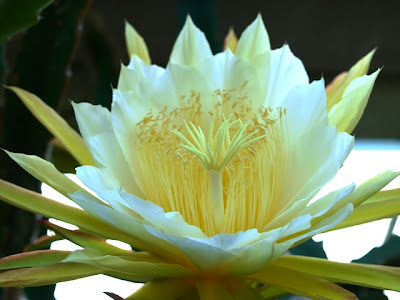Bragging about flowers in the dark
Can a plant get too much publicity? The Wollemi Pine (Wollemia nobilis) not only teeters on extinction but also on excess exposure. Flowering Titan Arum (Amorphophallus titanum) has becomes competitive enough to be considered as an Olympic sport for 2016.
Night-flowering Cacti must be getting close to media saturation. Every animated or acted sit-comm will one day include one of these plants in its story line, usually around the time it 'jumps the shark'.
I've already posted on Dragon Fruit the product of one cactus that flowers at night. At the time, while I was visiting Canary Islands, and all I could provide were the fruits. Now I can finish the story with some gorgeous flowers photographed this morning and the evening before.
The flowers of Hylocereus polyrhizus (a species producing Dragon Fruit) flower for only one night - already you can see the press release or television plot - and during the day they are either spent or waiting to do their thing. Luckily Lara Jewitt, Manager of the Princess of Wales Conservatory at Kew, sent out an email to Steve Hopper and me alerting us to the night-time show. Steve is out of town but I was able to drop in on Friday night and then again this morning (Sunday).
On Friday at 8.30 pm I saw this, the first flower about to open. Lara says it is usually fully open by 11 pm. I'd like to say I had a dance party to go to and couldn't hang around but that wouldn't be quite the truth. Let's just say it was dark and wet...
This morning, at 7 am (still up after dancing all night?) I found the next two flowers out in full. Lara says they stay open until at least 7.45 am when she comes into work.
I don't want to tell you all how to suck eggs but you just point your phone camera (assuming you a nice QR Code Reader app) at the sign and it takes you direct to our website.
What you also learn there is that the large, white flowers attract bats and moths. What you don't learn is how beautiful they are in life, and how tactile and subtly coloured. For that you need to be lucky enough to have access at night to the glasshouses at Kew, or grow one yourself.
Hylocereus polyrhizus grows naturally in Central America and the top of South America. Wikipedia seems to doubt this name prefers Hylocereus costaricensis for most specimens grown in cultivation, but I'm sticking with Kew's label and opinion for now. Enjoy Hylocereus polyrhizus!







Comments